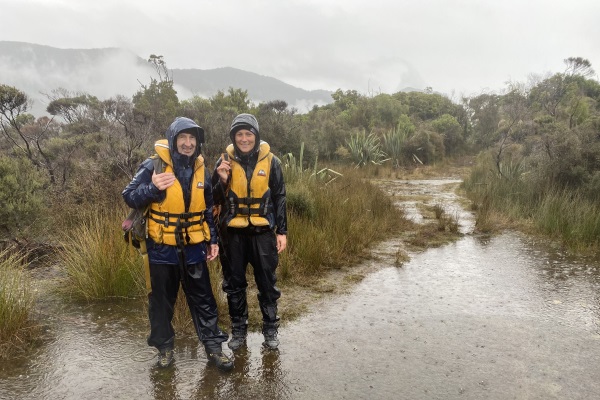
In a unique corner of Fiordland, the song of the kakaruai (South Island robin) can once again be heard trilling through the podocarps thanks to eight years’ hard mahi by a band of passionate conservationists.
Comprising stakeholders and landholders of the lower Hollyford Valley, the Hollyford Conservation Trust was established in 2014, after locals realised the native bush and birdlife was deteriorating.
The area, north of Milford Sound, runs inland from Martins Bay along Lake McKerrow and includes podocarp and southern rata forest, wetlands, and fragile dune systems, which are home to several species of endangered native birds and rare species such as tawaki (Fiordland crested penguin) and kotuku (white heron).
It’s also the only place in New Zealand where bottlenose dolphins swim into a fresh water lake.
‘‘We knew that there were biodiversity values in that particular corner of Fiordland that were extraordinary and worth protecting,’’ trustee Peta Carey, of Queenstown, says.
‘‘Everybody agrees it’s not just beautiful but there’s something special about the place.’’
Forming a partnership with the Department of Conservation (DoC), the trust aimed to buckle down in the race against predators eradicating native species in the area by securing private funding to help manage the biodiversity restoration of the lower Hollyford Valley, trust chairman Ron Anderson says.
‘‘DoC provided the ideas, the brains initially — we were just a bunch of people that were concerned about it and wondered what on earth we could do.
‘‘And as individuals we couldn’t do anything, but as a group we’ve become strong and we’ve become more independent.’’
Embarking on an intensive predator control scheme to combat stoats, rats and possums — initially installing traps and bait stations over 900 hectares of land, before extending coverage to the full 2600ha area — the trust’s now working on maintaining an extensive buffer around the area and translocating previously-locally extinct species, such as the kakaruai, back into the valley.
While Anderson says trying to run a predator-free project in Fiordland, a region without borders to help curb re-invasion, is a challenge, the trust’s gains have nevertheless been huge.
‘‘We’ve ended up covering the entire basin in the Hollyford and recently we’ve managed to encourage the people of Big Bay to join us and we’re looking to go further south so that the project might become one of the largest conservation projects in NZ.
‘‘If you get to 90% predator-free, that’s significant, and we’ve got to 90%, we’ve got to 95% at times … and our goal’s to get it down so that we stand a good chance of getting further-endangered birds reintroduced back into the Hollyford.’’
Not letting access and contracting challenges — entry to do the skilled control work is by air or a three-day walk — stymie the vision, the trust’s perseverance has meant visitors ‘‘are blown away’’ by the forest, Carey says.
‘‘They said they’ve never heard birdsong in Fiordland like this.’’
Working closely with Ngai Tahu Tourism, the trust’s focus is on expanding and strengthening predator control, however sights have also been set on reintroducing a very special native bird, Carey says.
“[It’s] kiwi — wouldn’t it be amazing?”



